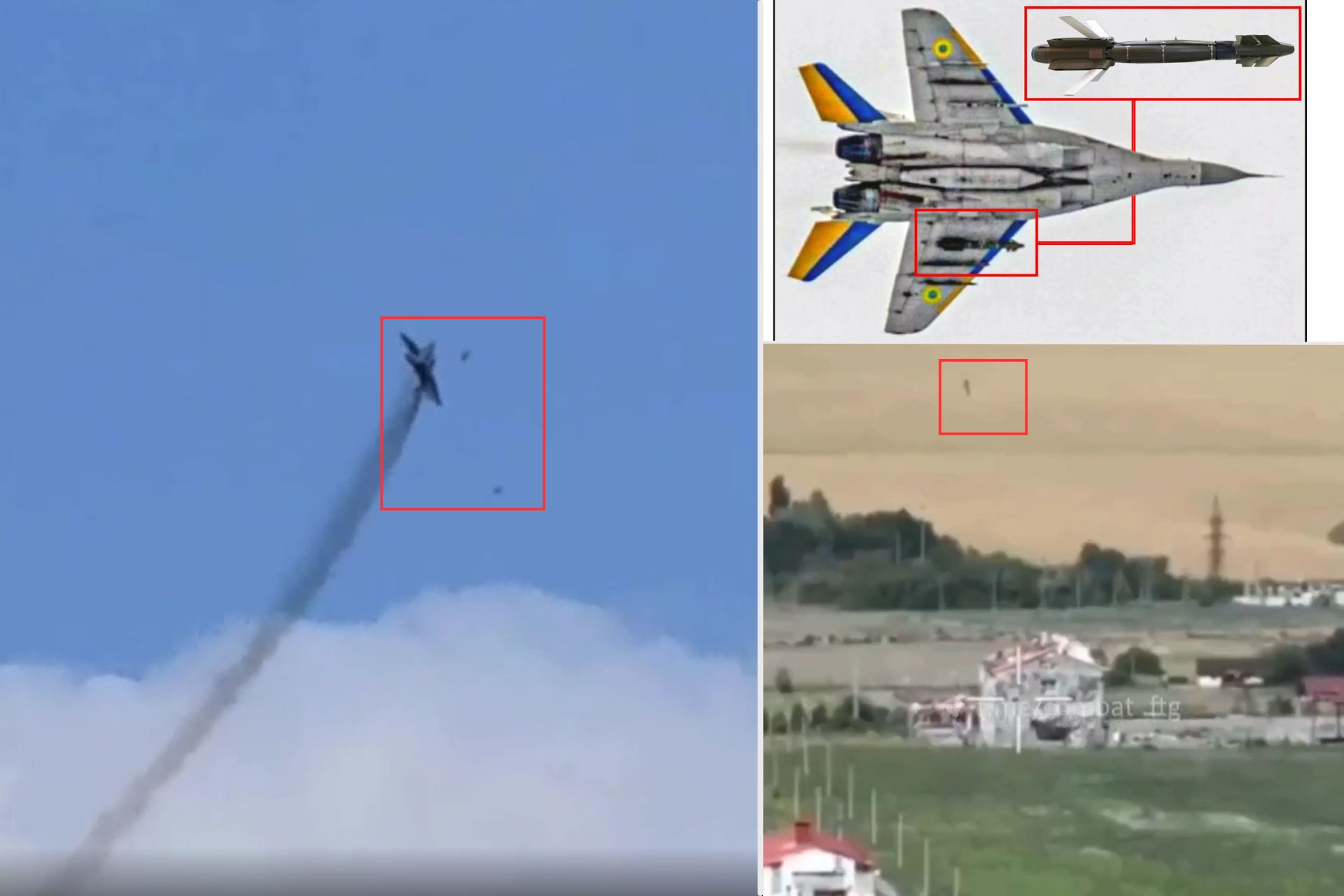Ukraine sucessfully strikes Belgorod with French guided AASM Hammer on Mig 29

{loadposition bannertop}
{loadposition sidebarpub}
In March 2024, the first images of a Ukrainian MiG-29 carrying French AASM bombs were released on Twitter. On June 2nd, 2024, a video surfaced showing a MiG-29 flying at low altitude and dropping two AASM bombs. This video was located in the Belgorod province in Russia, raising several questions upon viewing.Follow Army Recognition on Google News at this link
video capture of dropping moment of AASM Hammer (Picture source: Army Recognition)
The MiG-29, also known as the Fulcrum in NATO nomenclature, is a twin-engine fighter aircraft developed by the Mikoyan-Gurevich design bureau in the Soviet Union. Initially designed to counter Western fighter jets like the F-15 Eagle and the F-16 Fighting Falcon, the MiG-29 made its first flight in 1977 and entered active service in 1982. This aircraft is notable for its versatility and its capability to perform both air superiority and ground attack missions.
The MiG-29 can reach a maximum speed of Mach 2.25, approximately 2,400 km/h at high altitude. It has an operational ceiling of 18,000 meters and a combat range of 700 km, extendable to 2,100 km with external fuel tanks. The aircraft is powered by two Klimov RD-33 turbofan engines, which provide excellent maneuverability, particularly in terms of climb rate and tight turns.
The technical specifications of the MiG-29 include a length of 17.32 meters, a wingspan of 11.36 meters, and a height of 4.73 meters. The aircraft has an empty weight of 11,000 kg and a maximum takeoff weight of 18,000 kg. In terms of payload capacity, the MiG-29 can carry up to 4,000 kg of ordnance, including air-to-air missiles (such as the R-73 and R-77), bombs, and unguided rockets. It is also armed with a 30mm GSh-30-1 cannon for close combat. Its electronic systems include an N019 radar (or its modernized equivalent) capable of tracking and engaging multiple targets simultaneously, as well as an infrared targeting system to enhance its night combat capabilities.
The AASM (Armement Air-Sol Modulaire), also known as the Hammer, is a family of guided bombs developed by the French company Safran Electronics & Defense. The AASM Hammer is a guidance and propulsion kit that can be mounted on standard bombs of 250 kg, 500 kg, and 1000 kg. It transforms these bombs into precision-guided munitions using various guidance systems, including GPS/INS (Global Positioning System/Inertial Navigation System), infrared, and laser.
The guidance kit allows the AASM to reach distances of up to 60 km when dropped from high altitude.
In this video, a particular technique is observed: the MiG is alone, without escort, and flies at very low altitude to avoid SAM interceptions. Then, the aircraft climbs almost vertically to artificially increase the range of the AASM. Immediately afterward, the aircraft returns to its initial altitude. Technically, this is important as it relatively protects the aircraft from anti-aircraft system fire.
Although France has authorized these strikes on Russian territory, certain limits have been set. These strikes must be conducted exclusively on air bases and launch points for attacks on Ukrainian soil, such as air bases, helicopter bases, and long-range drone launch points. However, the available images show an isolated building, suggesting it might be a civilian dwelling. This raises a hypothesis of a failure to comply with the agreed conditions.

{loadposition bannertop}
{loadposition sidebarpub}
In March 2024, the first images of a Ukrainian MiG-29 carrying French AASM bombs were released on Twitter. On June 2nd, 2024, a video surfaced showing a MiG-29 flying at low altitude and dropping two AASM bombs. This video was located in the Belgorod province in Russia, raising several questions upon viewing.
Follow Army Recognition on Google News at this link
video capture of dropping moment of AASM Hammer (Picture source: Army Recognition)
The MiG-29, also known as the Fulcrum in NATO nomenclature, is a twin-engine fighter aircraft developed by the Mikoyan-Gurevich design bureau in the Soviet Union. Initially designed to counter Western fighter jets like the F-15 Eagle and the F-16 Fighting Falcon, the MiG-29 made its first flight in 1977 and entered active service in 1982. This aircraft is notable for its versatility and its capability to perform both air superiority and ground attack missions.
The MiG-29 can reach a maximum speed of Mach 2.25, approximately 2,400 km/h at high altitude. It has an operational ceiling of 18,000 meters and a combat range of 700 km, extendable to 2,100 km with external fuel tanks. The aircraft is powered by two Klimov RD-33 turbofan engines, which provide excellent maneuverability, particularly in terms of climb rate and tight turns.
The technical specifications of the MiG-29 include a length of 17.32 meters, a wingspan of 11.36 meters, and a height of 4.73 meters. The aircraft has an empty weight of 11,000 kg and a maximum takeoff weight of 18,000 kg. In terms of payload capacity, the MiG-29 can carry up to 4,000 kg of ordnance, including air-to-air missiles (such as the R-73 and R-77), bombs, and unguided rockets. It is also armed with a 30mm GSh-30-1 cannon for close combat. Its electronic systems include an N019 radar (or its modernized equivalent) capable of tracking and engaging multiple targets simultaneously, as well as an infrared targeting system to enhance its night combat capabilities.
The AASM (Armement Air-Sol Modulaire), also known as the Hammer, is a family of guided bombs developed by the French company Safran Electronics & Defense. The AASM Hammer is a guidance and propulsion kit that can be mounted on standard bombs of 250 kg, 500 kg, and 1000 kg. It transforms these bombs into precision-guided munitions using various guidance systems, including GPS/INS (Global Positioning System/Inertial Navigation System), infrared, and laser.
The guidance kit allows the AASM to reach distances of up to 60 km when dropped from high altitude.
In this video, a particular technique is observed: the MiG is alone, without escort, and flies at very low altitude to avoid SAM interceptions. Then, the aircraft climbs almost vertically to artificially increase the range of the AASM. Immediately afterward, the aircraft returns to its initial altitude. Technically, this is important as it relatively protects the aircraft from anti-aircraft system fire.
Although France has authorized these strikes on Russian territory, certain limits have been set. These strikes must be conducted exclusively on air bases and launch points for attacks on Ukrainian soil, such as air bases, helicopter bases, and long-range drone launch points. However, the available images show an isolated building, suggesting it might be a civilian dwelling. This raises a hypothesis of a failure to comply with the agreed conditions.







